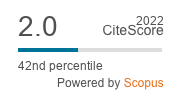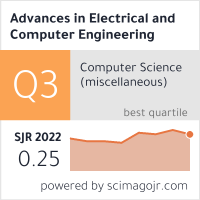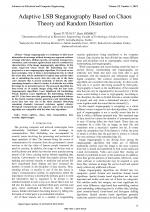| 3/2018 - 3 |
Adaptive LSB Steganography Based on Chaos Theory and Random DistortionTUTUNCU, K. |
| View the paper record and citations in |
| Click to see author's profile in |
| Download PDF |
Author keywords
ciphers, chaos, data encapsulation, data security, digital images
References keywords
image(17), steganography(15), chaotic(11), hiding(10), steganographic(9), information(8), algorithm(8), communications(7), signal(5), security(5)
Blue keywords are present in both the references section and the paper title.
About this article
Date of Publication: 2018-08-31
Volume 18, Issue 3, Year 2018, On page(s): 15 - 22
ISSN: 1582-7445, e-ISSN: 1844-7600
Digital Object Identifier: 10.4316/AECE.2018.03003
Web of Science Accession Number: 000442420900003
SCOPUS ID: 85052105181
Abstract
Image steganography is a technique to hide secret information in an image without leaving any apparent evidence of image alteration. Hiding capacity, perceptual transparency, robustness, and resistance against attack must be considered as characteristics of the image steganography algorithms. In this study, Improved Chaos Based Bit Embedding has been proposed as a new steganography algorithm. It is based on two basic principles. One of them is determining the bits in which the secret data will be embedded by logistic map and the other one is embedding the secret data into only one of the three color channels that is chosen randomly. It distorts the other remaining channels so that it is harder to obtain the text within the image by an unwanted person. The proposed algorithm has been tested on 10 sample images along with the four basic steganography algorithms: Least Significant Bit Embedding, Pseudo Random Least Significant Bit Embedding, EzStego, and F5. It has been seen that generating unpredictable indexes by the chaotic random number generators, and embedding the secret data into only one of the three channels (distorting remaining channels) increased resistance against attacks. Perceptual transparencies and capacity ratio of the proposed algorithm are compatible with the other four algorithms. |
| References | | | Cited By |
Web of Science® Times Cited: 9 [View]
View record in Web of Science® [View]
View Related Records® [View]
Updated 2 days, 22 hours ago
SCOPUS® Times Cited: 13
View record in SCOPUS® [Free preview]
View citations in SCOPUS® [Free preview]
[1] HNMH: A New Hybrid Approach Based on Near Maximum Histogram and LSB Technique for Image Steganography, Sondas, Adnan, Kurnaz, Harun, Wireless Personal Communications, ISSN 0929-6212, Issue 3, Volume 126, 2022.
Digital Object Identifier: 10.1007/s11277-022-09830-8 [CrossRef]
[2] Shared memory implementation and performance analysis of LSB steganography based on chaotic tent map, Gambhir, Gaurav, Mandal, Jyotsna Kumar, Innovations in Systems and Software Engineering, ISSN 1614-5046, Issue 4, Volume 17, 2021.
Digital Object Identifier: 10.1007/s11334-021-00385-8 [CrossRef]
[3] Multicore implementation and performance analysis of a chaos based LSB steganography technique, Gambhir, Gaurav, Mandal, Jyotsna Kumar, Microsystem Technologies, ISSN 0946-7076, Issue 11, Volume 27, 2021.
Digital Object Identifier: 10.1007/s00542-020-04762-4 [CrossRef]
[4] Quantum Steganography Using Two Hidden Thresholds, TUDORACHE, A.-G., MANTA, V., CARAIMAN, S., Advances in Electrical and Computer Engineering, ISSN 1582-7445, Issue 4, Volume 21, 2021.
Digital Object Identifier: 10.4316/AECE.2021.04009 [CrossRef] [Full text]
[5] Medical image steganographic algorithm via modified LSB method and chaotic map, Karawia, A. A., IET Image Processing, ISSN 1751-9659, Issue 11, Volume 15, 2021.
Digital Object Identifier: 10.1049/ipr2.12246 [CrossRef]
[6] An efficient steganographic technique for hiding data, Nashat, Dalia, Mamdouh, Loay, Journal of the Egyptian Mathematical Society, ISSN 2090-9128, Issue 1, Volume 27, 2019.
Digital Object Identifier: 10.1186/s42787-019-0061-6 [CrossRef]
[7] Dynamic Steganography Least Significant Bit with Stretch on Pixels Neighborhood, Harahap, Muhammad Khoiruddin, Khairina, Nurul, Journal of Information Systems Engineering and Business Intelligence, ISSN 2443-2555, Issue 2, Volume 6, 2020.
Digital Object Identifier: 10.20473/jisebi.6.2.151-158 [CrossRef]
[8] A novel non-equilibrium hyperchaotic system and application on color image steganography with FPGA implementation, Sun, Jing-yu, Cai, Hong, Gao, Zi-bo, Wang, Chun-peng, Zhang, Hao, Nonlinear Dynamics, ISSN 0924-090X, Issue 4, Volume 111, 2023.
Digital Object Identifier: 10.1007/s11071-022-07993-4 [CrossRef]
[9] A Modified Hash Based Least Significant Bits Algorithm for Steganography, Muyco, Stella D., Hernandez, Alexander A., Proceedings of the 2019 4th International Conference on Big Data and Computing - ICBDC 2019, ISBN 9781450362788, 2019.
Digital Object Identifier: 10.1145/3335484.3335514 [CrossRef]
Disclaimer: All information displayed above was retrieved by using remote connections to respective databases. For the best user experience, we update all data by using background processes, and use caches in order to reduce the load on the servers we retrieve the information from. As we have no control on the availability of the database servers and sometimes the Internet connectivity may be affected, we do not guarantee the information is correct or complete. For the most accurate data, please always consult the database sites directly. Some external links require authentication or an institutional subscription.
Web of Science® is a registered trademark of Clarivate Analytics, Scopus® is a registered trademark of Elsevier B.V., other product names, company names, brand names, trademarks and logos are the property of their respective owners.
Faculty of Electrical Engineering and Computer Science
Stefan cel Mare University of Suceava, Romania
All rights reserved: Advances in Electrical and Computer Engineering is a registered trademark of the Stefan cel Mare University of Suceava. No part of this publication may be reproduced, stored in a retrieval system, photocopied, recorded or archived, without the written permission from the Editor. When authors submit their papers for publication, they agree that the copyright for their article be transferred to the Faculty of Electrical Engineering and Computer Science, Stefan cel Mare University of Suceava, Romania, if and only if the articles are accepted for publication. The copyright covers the exclusive rights to reproduce and distribute the article, including reprints and translations.
Permission for other use: The copyright owner's consent does not extend to copying for general distribution, for promotion, for creating new works, or for resale. Specific written permission must be obtained from the Editor for such copying. Direct linking to files hosted on this website is strictly prohibited.
Disclaimer: Whilst every effort is made by the publishers and editorial board to see that no inaccurate or misleading data, opinions or statements appear in this journal, they wish to make it clear that all information and opinions formulated in the articles, as well as linguistic accuracy, are the sole responsibility of the author.





